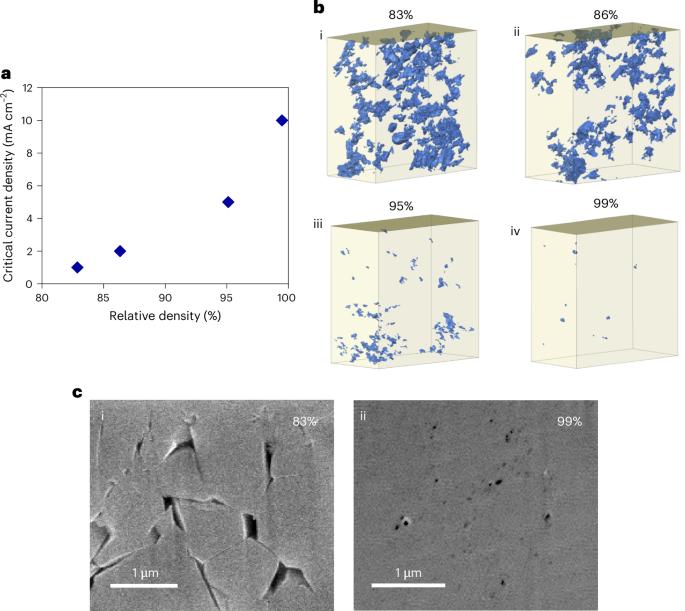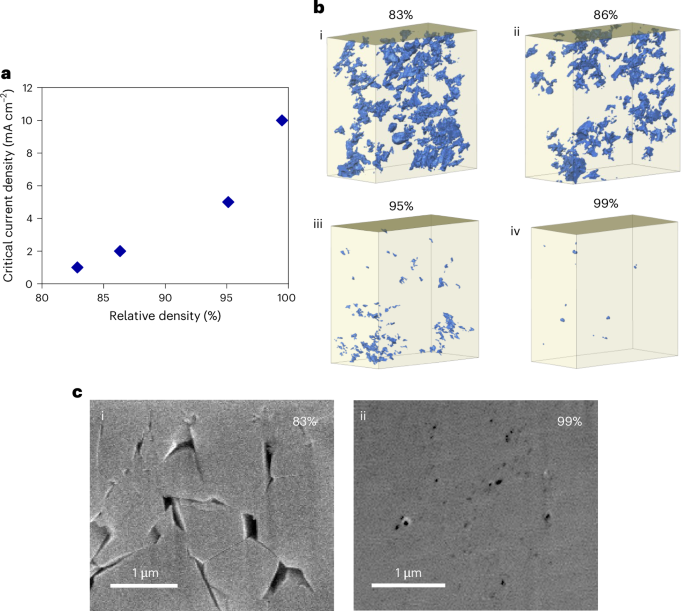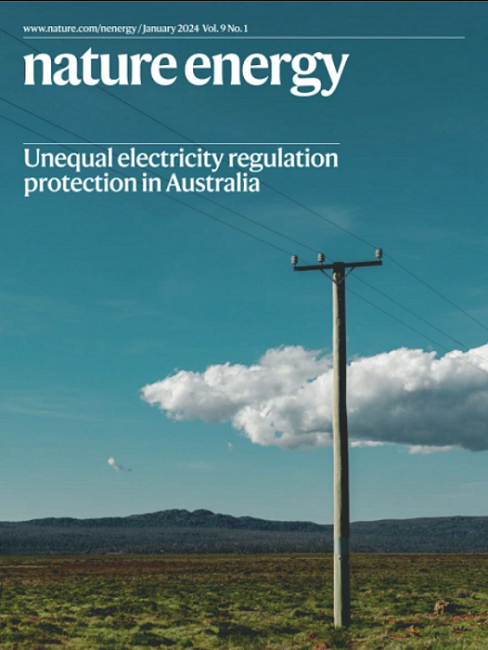High plating currents without dendrites at the interface between a lithium anode and solid electrolyte
IF 60.1
1区 材料科学
Q1 ENERGY & FUELS
引用次数: 0
Abstract
Avoiding lithium dendrites at the lithium/ceramic electrolyte interface and, as a result, avoiding cell short circuit when plating at practical current densities remains a significant challenge for all-solid-state batteries. Typically, values are limited to around 1 mA cm−2, even, for example, for garnets with a relative density of >99%. It is not obvious that simply densifying ceramic electrolytes will deliver high plating currents. Here we show that plating currents of 9 mA cm−2 can be achieved without dendrite formation, by densifying argyrodite, Li6PS5Cl, to 99%. Changes in the microstructure of Li6PS5Cl on densification from 83 to 99% were determined by focused ion beam-scanning electron microscopy tomography and used to calculate their effect on the critical current density (CCD). Modelling shows that not all changes in microstructure with densification act to increase CCD. Whereas smaller pores and shorter cracks increase CCD, lower pore population and narrower cracks act to decrease CCD. Calculations show that the former changes dominate over the latter, predicating an overall increase in CCD, as observed experimentally. High plating currents are achieved in solid-state batteries without dendrites by densifying Li6PS5Cl, with modelling showing how specific microstructural changes increase the critical current density.


高电镀电流,在锂阳极和固体电解质之间的界面上没有枝晶
在实际电流密度下电镀时,避免锂/陶瓷电解质界面处的锂枝晶,从而避免电池短路,仍然是全固态电池面临的一个重大挑战。通常,数值限制在1毫安厘米−2左右,甚至对于相对密度为99%的石榴石也是如此。简单地致密化陶瓷电解质并不能明显地提供高电镀电流。本文表明,通过将银晶石Li6PS5Cl致密化至99%,可以实现9 mA cm−2的电镀电流,而不会形成枝晶。利用聚焦离子束扫描电子显微镜断层扫描技术测定了Li6PS5Cl在密度从83%到99%之间微结构的变化,并计算了它们对临界电流密度(CCD)的影响。模拟结果表明,致密化过程中微观结构的变化并非都对CCD的增加起作用。较小的孔隙和较短的裂缝会增加CCD,而较小的孔隙和较窄的裂缝会降低CCD。计算表明,前者的变化占主导地位,后者,预测整体增加CCD,如实验观察到的。
本文章由计算机程序翻译,如有差异,请以英文原文为准。
求助全文
约1分钟内获得全文
求助全文
来源期刊

Nature Energy
Energy-Energy Engineering and Power Technology
CiteScore
75.10
自引率
1.10%
发文量
193
期刊介绍:
Nature Energy is a monthly, online-only journal committed to showcasing the most impactful research on energy, covering everything from its generation and distribution to the societal implications of energy technologies and policies.
With a focus on exploring all facets of the ongoing energy discourse, Nature Energy delves into topics such as energy generation, storage, distribution, management, and the societal impacts of energy technologies and policies. Emphasizing studies that push the boundaries of knowledge and contribute to the development of next-generation solutions, the journal serves as a platform for the exchange of ideas among stakeholders at the forefront of the energy sector.
Maintaining the hallmark standards of the Nature brand, Nature Energy boasts a dedicated team of professional editors, a rigorous peer-review process, meticulous copy-editing and production, rapid publication times, and editorial independence.
In addition to original research articles, Nature Energy also publishes a range of content types, including Comments, Perspectives, Reviews, News & Views, Features, and Correspondence, covering a diverse array of disciplines relevant to the field of energy.
 求助内容:
求助内容: 应助结果提醒方式:
应助结果提醒方式:


